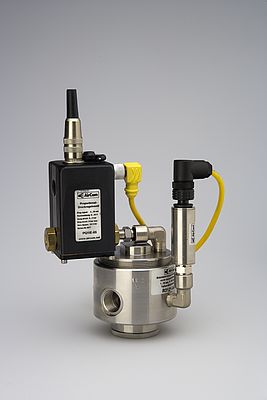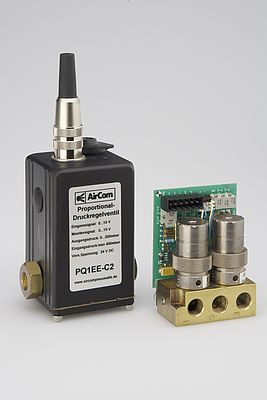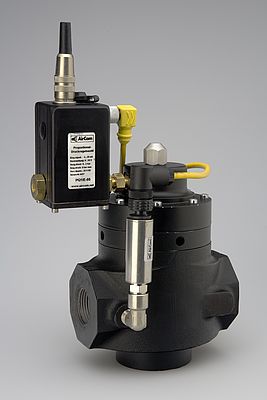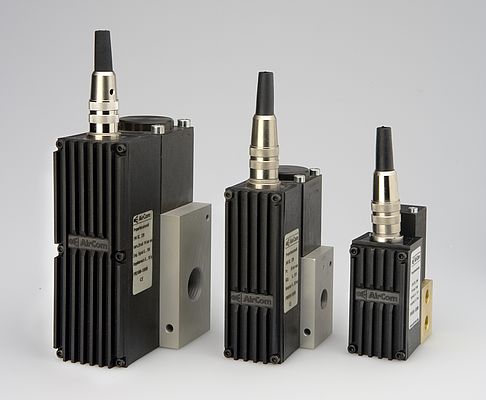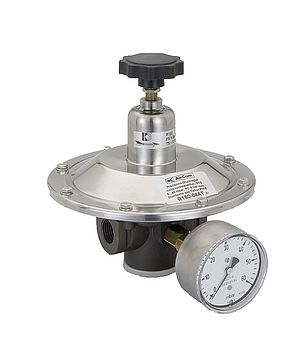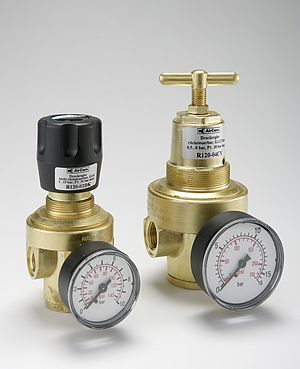Electronic drive and control equipment plays an important part for control technology in modern plants. There are, however, many applications in which pneumatics can show is advantages, for instance in positioning and testing processes. Proportional valves are available for this. They function with high precision.
Pneumatic regulating systems have been in use in process engineering for a long time. In machine and plant engineering, there are also many applications of such systems. Aircom Pneumatic offers you, in its broad range of pneumatic regulating devices, many components for such applications. They should be described in detail here, using some case studies.
Primarily proportional pressure regulators find application frequently. These are regulating devices that regulate the pressure in the compressed air infeed analogue to an electrical input signal. The classical input ranges are available here of 0 to 10 V, 4 to 20 mA, but also control via Interbus or Profibus. An internal pressure sensor constantly measures the output pressure and compares it with the input signal. If the input signal deviates from the feedback signal, the output pressure is increased or reduced internally by two solenoid valves or a proportional valve until the desired output pressure is achieved again. The system functions as a closed regulator circuit.
Of special advantage is the variable configuration of the output pressure ranges, for example from -100 to +100 mbar or 5 to 50 bar; all conceivable variations in the vacuum and overpressure range are feasible.
Pneumatics in special application
By no means have all possibilities been exploited with the application in the classical compressed air field however that can be reached by the modern systems. The performance of the systems developed by Aircom has grown continuously with the steadily increasing demands from all industries. Special gases that are especially pure are employed for applications in the foodstuff and pharmaceutical industries. Special requirements need to be fulfilled here. The media-contacting materials of the proportional pressure regulators have to be made of stainless steel. As elastomers for the seals, only FDA-authorised materials may be used. When employed for burning and cutting systems the tolerance with oxygen is indispensable. When using oxygen the parts that contact the media must be free of oil and grease. Due to the necessary dynamic sealing this is not possible. Special lubricants are employed here then that are legally certified and authorised for oxygen. Thus, special seals are available, for example for the application of helium and hydrogen, that achieve optimal operational results.
Further possible operational limitations are mandated by ambient conditions such as potentially explosive atmospheres. Various models are available for this in different pressure ranges for use in explosion G- and explosion D-ranges.
Uniform web tension and impermeability
One of the applications of these devices is the control of uncoiling brakes where a uniform web tension needs to be ensured. An ultrasonic sensor measures the current diameter of the reel and correspondingly sends a signal to the proportional valve. This applies its output pressure to the brake. Thus, the same web tension is always created independently from the reel diameter. A special advantage of this system is that the proper brake pressure is set before the winding motor is started. This prevents web tears on sensitive materials.
All plastic containers, from the shampoo bottle to the gas tank in cars, need to be checked for impermeability. When there are constantly changing bottle sizes, a defined pressure volume needs to be filled in. Proportional valves with a precision of 0.2 % provide their service here. They keep up with the high rates of modern blower systems without a problem.
Proportional regulator with 2nd feedback
Unforeseeable disturbance variables can occur on some regulating systems. On such applications, it is necessary to think outside of the box of the small regulator circuit. Proportional equipment offers integrated solutions here. Complex regulating functions can be easily realised by it. This function expands the possible application variants many times over.
The subject is about proportional valves with overlying 2nd feedback or "second loop". These proportional pressure regulators function according to the same principle as described above. However, an additional function is employed by the second actual value input. The second sensor is read in addition to the internal signal. The input signals are processed in a ratio of 10 to 90 % and sent as output pressure. The advantage of this 2nd feedback is that not only can an additional pressure sensor be read in, but also temperature sensors, tension sensors or, as shown in the following example, a load cell.
A frequent application for this type of device is the combination with a flow-rate booster or a pilot-controlled pressure regulator. Here this proportional pressure regulator is employed as a pilot regulator. On standard flow-rate booster systems, there always is a drop of the output pressure when there is a switch between static and dynamic operational conditions. This causes undesired effects, especially at low operational pressures.
By registering the actual value with a pressure transducer at the output of the flow-rate booster and the feedback of this value to the proportional valve, the pilot pressure is increased in this case. This completely compensates the fluctuation of the output pressure during various operational conditions.
Furthermore, such systems also offer the employment of electronic regulators in ranges with high temperatures. Flow-rate boosters as well as pressure transducers for media temperatures up to 130 °C are offered. The proportional valve can thus be mounted at some distance from the control cabinet.
Compensation of various weights for balancers
At known weights, a set value is applied by the proportional valve onto the cylinder; thereby compensating loads weighing tonnes and making them easily manageable. A force gauge that always registers the current weight is used as 2nd feedback. Should the current weight deviate from the set value, the weight difference is compensated by the 2nd feedback.


